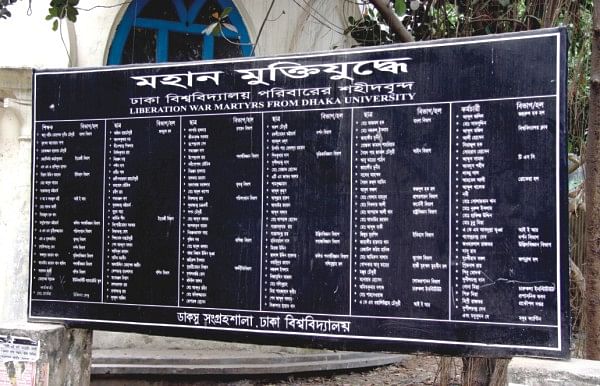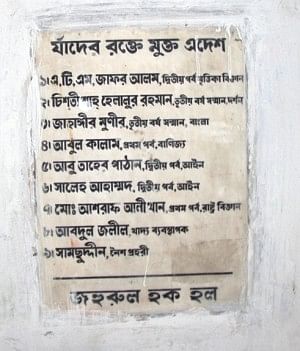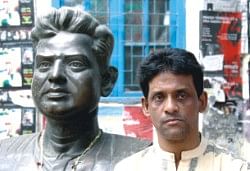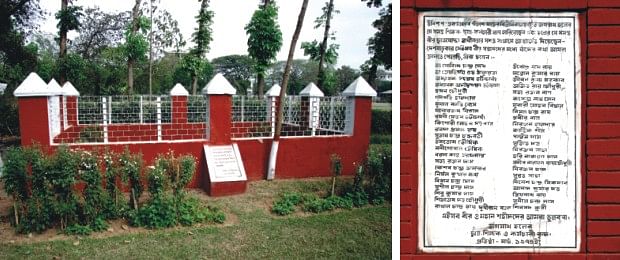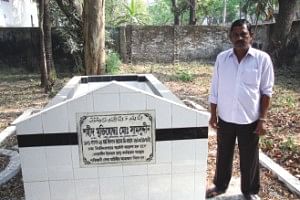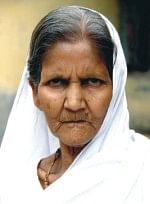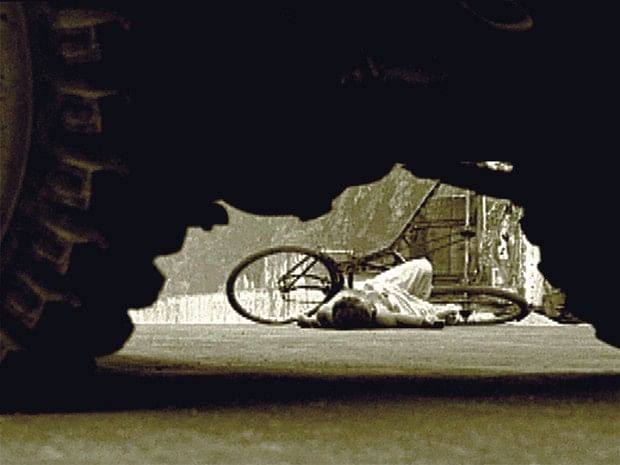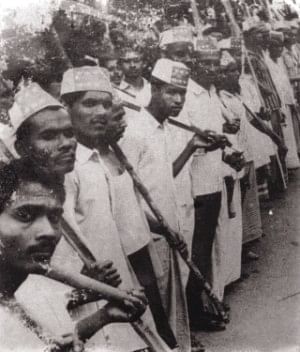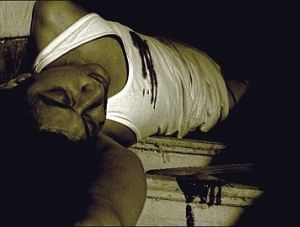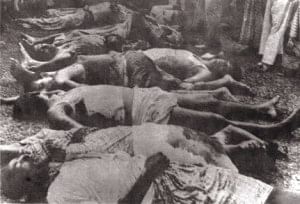| Home - Back Issues - The Team - Contact Us |
 |
| Volume 10 |Issue 12 | March 25, 2011 | |
|
|
Cover Story The Sound of Approaching Boots What had happened in Dhaka on the night of March 25, 1971 has been carved permanently in the collective consciousness of Bangladeshi people as the darkest night in history. Teachers, students and officials of Dhaka University along with ordinary people and the armed forces of the erstwhile East Pakistan were caught unawares by the Pakistani army who, well equipped with ammunition and tanks, engaged in an orgy of killing totally unarmed, unprepared people most of whom woke up from sleep only to face death or see their near ones die before their very eyes. The targets of the occupation forces are by now well known. So are the reasons as to why they were very selective in launching the deadly crackdown which was later extended even to the remotest village. As such, the time from the early hours of March 26 to the lifting of curfew next day, has found a central place in the historiography of independent Bangladesh. Many writers and historians have also shown how calculated this crackdown was. But in the midst of all these objectively written narratives, there has been a real dearth of a subjective account, a retelling of the events from those who had survived the mass killing project. Without such an authentic account one can hardly get a complete as well as a concrete picture of the gory death scenes and the trauma ensuing from them. Besides, it is only then one can comprehend the true range of the sacrifice made by the martyrs and the injustice done to their families afterwards by successive governments.
Rifat Munim
Kaliranjan Sheel, a veteran activist of Communist Party of Bangladesh, was one in a very few who had survived the clampdown on Jagannath Hall that night. In an article titled Jagannath Hall-ei Chhilam (I was at Jagannath Hall that Night), he gives a vivid picture of what had actually happened there. Having completely surrounded the Jagannath Hall, the Pakistani army first launched a deadly shell and arson attack on the hall. The crushing nature of the attack made it clear that the mission was to enact a holocaust, gunning down every living soul staying there. Yet, miraculously, Sheel had survived although how this was possible would continue to baffle him all his life. While the mortar shell attacks were going on, the army gutted most parts of the dormitory. Then they barged into the rooms and indiscriminately fired bullets into the hapless students. However, some students, including Sheel, were spared because of the darkness. But as the day broke, they caught all the students red handed and asked them to carry the corpses scattered here and there, and to heap them in a corner of the field. Finally, they ordered the remaining students to line up beside the stacks of corpses to complete their mission. But Sheel was too overworked to stand on his feet, so he fell on the ground right before the bullets could hit him. This was the breathtaking tale of how Sheel had cheated death. Yet, disturbing memories of that horrifying night might have taken their toll accordingly, precipitating an early death of one of the few survivors of the Jagannath Hall carnage.
Rashid Haider, the editor of the book 1971: Bhoyaboho Aubhigyata (1971: Terrifying Experience) in which Sheel's article was anthologised, says, “Sheel was my age. But unfortunately he died several years ago, which seemed a premature death.” According to Haider, there was another student who had survived too. “There was an Asim who also had survived that attack. But he seems to have disappeared without a trace,” adds Haider. Abu Musa M Masuduzzaman is another witness whose survival had rested solely on his being a child at that time. His father, Professor ANM Muniruzzaman, head of Department of Statistics, was gunned down that night along with his uncle Advocate Shamsuzzaman, his elder brother Akramuzzaman and his cousin Syed Nasirul Wahab. The cold-blooded murders were all executed in front of an ill-fated Masuduzzaman who was only 13 in 1971 and who still grapples to come to terms with the traumatic effects of those memories. Several troops, well prepared with lethal weapons, entered the streets of Dhaka University in the early hours of that fateful night. Some took position in front of the Shamsunnahar Hall, while some kept moving to keep surveillance. In the first phase of the diabolic Operation Searchlight, Masuduzzaman relates, the army had assaulted the teachers' residential area near the Shaheed Minar to kill a number of previously identified teachers who were believed to have masterminded a clandestine preparation for war, including training among the students. The hunt for the targeted ones began with ANM Muniruzzaman.
“It was shortly after midnight that we heard knocks on the door. After opening the door, a lot of army personnel entered our flat and asked for my father. When my father appeared, they asked him his name and profession as if they were cross-checking information. They also interrogated the other males: my uncle, elder brother and cousin. Then they took them down on the ground floor. One of the officers took me as well,” recollects Masuduzzaman. Only women were left inside the flat. While his mother, sisters and other women were weighed down by the ominous situation, he was standing in the staircase leading to the second floor and saw all others standing in front of Professor Jyotirmoy Guhathakurta's flat on the ground floor. Then after one or two words with his father, which he remembers was an altercation about kneeling down, they shot his father at point-blank range right on the forehead. Muniruzzaman died immediately. One by one they shot the others. His uncle and cousin died on the spot, but his elder brother with two bullets in the lower abdomen was still alive. Next they headed for the building where GC Dev lived. After killing Dev, the troop left the place only to return shortly thereafter to track the then Jagannath Hall provost Guhathakurta down. After catching him, they did not line him up in front of his flat where other corpses were laid down. He was rather dragged outside and shot in the neck and ears. Then the troops finally left for teachers living in other places in and around the university. Towards the morning, another troop came by. Meanwhile Basanti Guhathakurta, with the help of Masuduzzaman's family, dragged her husband back inside the flat. So they only found Masuduzzaman's elder brother still breathing and gasping for some water. They shot him again to finish the job. However, Guhathakurta died several days later at Dhaka Medical College Hospital. “We also tried to take my elder brother back into our flat, but he had refused to go since he was too injured to move an inch. Plus everyone was already frightened about the safety of the girls staying indoors,” explains Masuduzzaman. By then the second phase had already begun, which was to witness the deadliest carnage at university dormitories. While the army was hunting down every single student staying in the dorm, towards the morning some of them broke into the employees' lodgings within the Jagannath Hall compound, where the Hindu officials of the dorm as well as that of the university used to live. Monbhoran Roy, who was then an employee of the National Institute of Public Administration at Dhaka University, was one of those few unfortunate Hindu officials who were caught and taken to the dorm to carry students' corpses.
“There were about fifty families living here, but they just arrested five or six men, my husband being one of them,” recollects Rajkumari Roy, wife of Monbhoran. “At first the army had said that they would get him to work and release him afterwards. But when all the corpses were carried and graves were dug, they also aligned him with the students and brushfired him,” says Roy. Silence descended upon the whole compound after the brushfire had ceased. But soon the silence was broken with sporadic cries of 'save me' or 'give me some water'. As the army had left the compound by then, a few dared to go near the stacks of corpses only to find that many had already been buried while many were just left to die away in a pool of blood. Monbhoran was among the latter group. Although he outlasted others, he also died in a few hours. “It is now established that my husband is one of the martyred officials of Jagannath Hall. But his name is not even inscribed in the list of the monument built in their memories. Ever since it was put up after independence, I have raised it and let the concerned authorities know about this, but it has always gone unheeded,” says a despondent Rajkumari. At present, she lives at the same place with her two sons Bindu Roy and Bimol Roy. Bindu now works as a staff for the Curzon Hall but Bimol, Rajkumari laments, does not have a good job and the university authority is not concerned about this.
Arun Kumar Dey, another eye witness to the massacre, was only eleven at that time. His father Madhusudan Dey, owner of the famous Madhu's canteen which is still regarded as the political hub of progressive students, lived in the DU staff quarters, which was close to the teachers' quarter. Everyone was awake because of the heavy as well as penetrating sound of gunfire and mortar shells. Arun's father was already tense with fear. Yet in the morning at around 7am, having taken a shower, his father was offering worship to a Hindu goddess, his newly wed brother Ranjit Kumar Dey was freshening up, and his mother Jogmaya Dey and sister-in-law Rina Rani Dey were in the kitchen. Then they entered the flat asking for Madhusudan Dey. Arun, though a child at that time, can graphically recollect everything that had happened that morning. “Some of them took my father out, and others broke into the rooms to vandalise things, especially the Hindu religious materials, and photos of Bangabandhu Sheikh Mujibur Rahman. Seeing them shatter everything, my sister-in-law screamed in fear. When they began to accost her, my brother came to her rescue, and he was shot dead right there. Then they shot my sister-in-law,” continues a crestfallen Arun. “Now came my father's turn. When they were poised to shoot, my mother appeared there abruptly and covered him. But nothing could deter them from shooting. As a result, they sprayed my mother's body with so many bullets that flesh from many parts of her body was sagging out. One or two bullets crossed my mother's body into my father's. Although bullet-hit, he was still alive. Then they dragged my father out in the corner of the Jagannath Hall field where the corpses were piled up.” The rest of Madhusudan Dey's story has already been recounted above. The corpses of the professors and officials were not returned and buried in the mass graves with the students in the dormitory field. While there was no sign of resistance from Jagannath Hall or any other hall, (nor was it possible), people say that Shamsuddin, the security guard of the then Iqbal Hall (now Zahurul Huq Hall) was the only person who fired several bullets on the advancing Pakistani troops. Under the supervision of DUCSU (Dhaka University Central Students' Union) of which ASM Abdur Rab was the vice president and Abdul Quadar Makhan the genral secretary, senior students began to provide combat training to members of Students' League and left leaning Students' Union using both real and dummy rifles stored in room number 1052. A reference to such training in Jagannath Hall can also be found in Sheel's article. So it is very much possible that Shamsuddin grabbed a rifle from there and fired back in resistance.
“I have always heard people say so, but I don't know if it is true because my brothers found his corpse on March 27. Other guards or officials were either killed or too frightened to recollect things correctly,” says Md Shajahan, son of Shamsuddin, who now lives in a DU staff quarter near the Shib Mandir. Students of this Hall had faced almost a similar fate, a realistic description of which can be found in an article by Selina Hossain, anthologised in the same book by Rashid Haider. Apart from Rokeya Hall, both Masuduzzaman and Arun affirm, a vast area adjacent to DU especially the Katabon slum was set ablaze and a lot of people were massacred. This is just a glimpse of what had happened to the DU teachers, students and officials on that night. Forty long years have passed since we gained independence. But what has happened to the martyrs' families of DU afterwards is another harrowing tale of how we fail to respect those who deserve the most. Till 1975, things were going on well with the families who were rehabilitated and provided allowance and other facilities. But following the political upheavals in 1975, things began to change. The meagre allowance that began with Tk 200 in 1972 mounted to Tk 700 later, which stopped altogether in 1990 with the establishment of democracy. Worse, the university authority vacated the martyred intellectuals' families from the university quarters. In case of the DU officials' families, though they were not vacated from their quarters or lodgings, occasionally they are given notice to vacate their places. To address all these issues, Masuduzzaman along with others formed the Dhaka University Shaheed Paribar Kalyan Samity. Following the continuous demand from the martyrs' families across the country, the government in 2000 exempted martyrs' families from electricity bill (200 units per month). Together with this one, martyrs' families all over the country get considerable monthly allowance and other facilities. The DU martyrs' families, on the other hand, do not receive any monthly allowance, and began to enjoy the exemption of electricity bill only from 2009. Referring to a letter issued to the vice chancellor of Dhaka University by Bangabandhu Sheikh Mujubur Rahman in 1972, Masuduzzaman says that they are entitled to lifelong rehabilitation, allowance and proper treatment from the university authorities. “All we get now is an exemption of electricity bill which has come into existence since 2009. Most of the martyred teachers' families were literally ousted from here. And we do not get any allowance either from the government or from the university authority,” adds Masuduzzaman. “Some of us get accommodation facilities, but not all of us. We do not get any other facilities such as job opportunities,” says Shajahan. But Rajkumari raises another issue. She says, “I don't want money, I just want the authorities to include my husband's name in the list engraved in the monument of the Jagannath Hall. And then I want them to give my Bimol a job. And I'm sure that we deserve it.” Failing to show respect to the martyrs' families is tantamount to forgetting the history of our independence, especially what it cost us and how we gained it. A nation without a sense of its history, needless to say, is compelled to plunge into chaos. May be it is time for us to rise above all political division about the martyrs' families of DU and ensure the rights to which they are entitled.
The Conspiracy Behind Operation Searchlight Tamanna Khan It was only 11.30 pm on March 25, 1971- still one-and-half hours to go before the planned H-hour (the specific hour at which a military operation commences), yet troops in jeeps loaded with machine-guns and rocket launchers began to move out of Dacca (the prior spelling of Dhaka) Cantonment. From that fateful hour onwards, the 57 Brigade under Brigadier Jahanzeb Arbab and in overall supervision from Major General Rao Farman Ali Khan, initiated their killing spree on the sleeping Bengalis of Dhaka, most of whom were unarmed and unaware of the crackdown named as Operation Searchlight. The main targets for attacks were Bangabandhu Sheikh Mujibur Rahman's house in Dhanmondi, Rajarbagh Police Headquarters, East Pakistan Rifles (EPR) Lines at Pilkhana, Dhaka University- mainly Iqbal Hall (the present day Zohurul Haq Hall) and Jagannath Hall, Liaquat Hall (the present day Suhrawardy Hall) of Engineering University (BUET), the office of "The People's Daily"- a newspaper that voiced the Bengali movement, Nawabpur and other old Dhaka areas with majority of Hindu residences. Besides these, the Pak army set ablaze and opened fire randomly at slum areas near railways and bazaar areas on either side of Mymensingh Road. They also fired mortar shell at the Press Club and killed teachers and university staff, mostly Hindus, at the Dhaka University teacher's quarters.
Looking back in history, the question arises as to why the Pakistani military junta resorted to such violence instead of opting for a political solution in answer to the demands of the Bengalis of East Pakistan? On what basis, did they select their targets and what was the ultimate objective of Operation Searchlight? The political and economical disparity between East and West Pakistan was the main cause of Bengali agitation since Partition. Dr Shawkat Ara Husain, Chairman of Political Science Department, University of Dhaka, says, "The lion’s share of the resource of the country used to come from East Pakistan particularly from jute. They did not share the earnings from jute; they used to give us only 19 percent." Mostafa Mohsin Montu, Organising Secretary of Gonoforum and a Chattra League member in East Pakistan, provides some glimpses of inequality. He recounts, "The price of paper in East Pakistan was ten annas per dista (rim) whilst in West Pakistan it was subsidised and sold for only six annas. This aggrieved the students. People used to bring in gold from West Pakistan because the price of gold was 100 rupees in West Pakistan and 120 rupees in East Pakistan." He adds that discrimination against the Bengalis existed everywhere in jobs, business, education, scholarships and especially in the army. To bring an end to the disparity, Bangabandhu Sheikh Mujibur Rahman, president of Awami League, presented the Six-point programme at Lahore in 1966, which demanded a federal and parliamentary government in which members will be elected by universal suffrage with legislative representation on the basis of the population. Some of the sensitive issues of the Six-point programme were the demand for federal government's power to taxation and revenue collection, control of foreign exchange earnings and trade relations and power to raise paramilitary forces. In their books "How Pakistan got Divided" by Major-General (Retd) Rao Farman Ali Khan, "The Betrayal of East Pakistan" by Lt Gen A A K Niazi and "Witness to Surrender" by Siddiq Salik (Public relation Officer of Pakistan Army, 1970-71), all three West Pakistani army men have acknowledged the impoverished state of East Pakistan and non-existence of a common element of unity other than religion. Rao Farman even mentions that "a federal form of government with greater autonomy to East Pakistan" could have changed the unequal circumstances of the two wings. Yet all three vehemently criticise the Six-point programme and consider it as a secessionist conspiracy. "They were always afraid that East Pakistan would break away. Beyond the surface they always knew that they were doing injustice to East Pakistan by not giving autonomy or a part in the administration of the nation," comments Dr Husain. She adds that the landslide win by Awami League (AL) in the 1970 election firmly established the fear of secession in the minds of the Pakistanis. In fact, in their books both Rao Farman and Siddiq Salik undermine the victory of AL indicating that the party used muscle power to win the election. They have also criticised the then President and Martial Law Administrator, Yahya's flexible Martial Law rule in handling the situation. The fact that West Pakistani military never accepted the victory is evident in Siddiq Salik's book that relates the story of a General in Yahya's confidence who commented, 'Don't worry … we will not allow these black bastards to rule over us.'
Their misgivings about the Bengalis soon became clear. Under the pretence to allow time for the making of constitution and calling of National Assembly, Yahya sided with the West Pakistani leader Bhutto, whose party Pakistan People's Party (PPP) won the majority seats in West Pakistan. In all three above mentioned books, the West Pakistani army men refer to Yahya's meeting with Bhutto at Larkana on January 15, 1971, as a ploy to curb Mujib's, aspiration. Niazi even mentions, "the plan which came to be known as the MM Ahmed plan aimed at abandoning East Pakistan without a successor government which meant losing the war." The first written official plan for a military action came about towards the end of February. "22nd of February, 1971, a meeting was called at the General Headquarter at Rawalpindi that Central government's writ will be applied strongly that is Martial Law was to be re-imposed in the true sense. Admiral S M Ahsan wrote down an operation for this. In the army, any operation or exercise has a code name. The name of this particular operation was operation BLITZ," says Major Qamrul Hassan Bhuiya (Retd), Chairman and Chief Researcher, Centre for Bangladesh Liberation War Studies. Although the basis of "BLITZ" was made on civil cooperation, West Pakistani troops and ammunition began to arrive in East Pakistan in huge numbers. Salik writes, "The Bengali brigade major was kept out of this arrangement for reasons of security. But hundreds of troops landing at Dacca, an airport manned mostly by Bengalis could not be kept a secret." "1st March the whole situation took a new dimension. On 3rd March Assembly was to be seated in Dhaka. On 1st March, East Pakistan time 13:05, Yahya announced that sitting of the Assembly has been declared closed sine die," recounts Major Qamrul. This ignited huge protest throughout East Pakistan and Mujib initiated his famous non-cooperation movement. The situation became so hostile that Yahya on his visit to Dhaka on March 15, 1971, while meeting with the army staff is quoted by Salik, saying "Don't worry. I will line up Mujib tomorrow… If he does not behave, I know the answer." The answer obviously indicated towards brutal military action. According to Salik, when meeting between Yahya and Mujib failed, Yahya called General Tikka Khan and told him to get ready meaning that planning and paper preparations for army action could start. In "Witness to Surrender" Salik mentions that Operation Searchlight was drafted by Major-General Khadim Raja and Major-General Rao Farman Ali at the office of General Officer Commanding at Dhaka on March 18, 1971. However, in his book, "How Pakistan got Divided", Rao Farman disputes the date of plan formation to be on March 23 and often repeats that the strategy was to display "fire power than its actual employment". His claim is in direct conflict with the text of Operation Searchlight which asks for "Surprise and Deception" as a prerequisite of success. It urges the president to continue dialogue with Mujib and deceive him by expressing his willingness to accept AL demands. This allowed the military intelligence time to prepare the detailed list of targets and gather strength.
Rao Farman also mentions that their recommendation in the original plan was to arrest all political leaders during a meeting with the president, but it was rejected by Yahya as he did not "want to come down in history as a traitor to democracy". When Major Qamrul was asked about the absence of killing instructions in Operation Searchlight he explains, "that instruction was verbal. In Operation Searchlight, there is a paragraph - allotment of troops to task. These are military terminologies or military expressions. Allotment of troops to task means how many soldiers should be allotted for which task. You will see, it also mentions different halls of Dhaka University. What would they do after going there? Would they arrest them (the students)? So, otherwise they meant that they should be eliminated." Montu throws light on why Dhaka University was the main target saying arms training camps were being set up at different places in the country since the beginning of March 1971. "In the beginning, the trainings at Iqbal hall would start at 2 am and continue till 4 am in the night to maintain secrecy, "he informs, "the women used to take training at Rokeya Hall. There was another training camp at Jagannath Hall." The military had special grievances against the teachers and the Hindu community. Dr Husain says, "They believed that the teachers are the mentors, they are the policy makers and they are instigating the students." Her point is proved in Niazi's book where he writes, "the vast majority of teachers in schools and colleges were Hindus. The teachers played an important role in moulding the ideas of the youth in their formative years." This animosity about the Bengali Hindus was open among the West Pakistanis, as mentioned in "The Cruel Birth of Bangladesh" by Archer K Blood, the then American Consular General in East Pakistan. He writes, "When talking with us, the West Pakistani Residents in East Pakistan often equated 'wicked Hindus' and 'wicked Indians', using the terms interchangeably." Montu adds that Pakistanis tried to prove to the general public of West Pakistan that the demands are not of the Bengalis but only of the Bengali Hindu populace. "They tried to create a communal sentiment. They even tried to sell this idea to the international community." "There are some psychological aspects of persecutors. They decided to kill unarmed people because it is the unarmed people who usually take part in a movement. So these unarmed people should be killed in such a way that Bengalis would never dream of struggle again and never even try that. Their aim was to terrorise the masses," explains Dr Husain in reply to why civilians were killed. Mohammad Rafiqul Islam, Chairman of Peace and Conflict Studies, University of Dhaka, explains, "There are two aspects of these kind of state initiated violence- one theoretical another psychological. Theoretical aspect of war studies, civil war, and separatist movement shows that dominant class usually takes a destructive resolution rather than a peaceful one. This trend was visible since the 60s and continued till the 90s, because alternative peaceful policies like conflict transformation and management and power sharing have not evolved yet. As a result the Pakistani ruler took the suppression policy. Psychologically the dominant class resorts to suppression to weaken the subordinate class. Pakistani rulers had power and international support so on March 25, they could carry out military action against the helpless Bengali community. We see similar instances in the civil wars of Africa and in Kashmir-India conflict." On the question of objective of Operation Searchlight, Major Qumrul says, "they had no precise and defined objective. For example whenever we plan an operation we set a start and an end date. This operation plan stated the commencing date but did not mention the ending date." He adds that it was rather a killing plan where the number one target was the AL members. The lack of foresight in Operation Searchlight was also obvious in the 'selective genocide' (the term first used by Blood in his telegram to the US State Department briefing on the events of East Pakistan in March 28, 1971) of the East Pakistani Hindus. The Pakistani Army's attempt to cleanse East Pakistan of its 10 million Hindus was viewed by Blood as a 'formidable task'. Their expectation that Hindu refugees' flight to India would not bring about international attention or a probable Indian intervention in the war was also a huge miscalculation. Operation Searchlight unleashed with full force and ferocity on the night of March 25, 1971, instead of taming the free-spirited Bengalis it only made them stronger and gave them yet another reason to fight for a independent nation. Rao Farman, one of the main architects of this plan, admits in his book that the decision of taking a military action had "undone Pakistan". Niazi in his book "The Betrayal of East Pakistan" refers to the night as a "display of stark cruelty". Yet 40 years later, the crimes committed and later admitted by these people still go unpunished. Copyright
(R) thedailystar.net 2010 |
